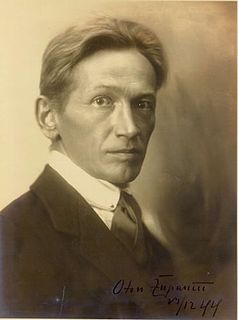This article needs additional citations for verification .(January 2017) (Learn how and when to remove this template message) |

Ivan Grafenauer (7 March 1880 – 29 December 1964) was a Slovenian literary historian and ethnologist of Carinthian Slovene origin.

Slovenia, officially the Republic of Slovenia, is a sovereign state located in southern Central Europe at a crossroads of important European cultural and trade routes. It is bordered by Italy to the west, Austria to the north, Hungary to the northeast, Croatia to the southeast, and the Adriatic Sea to the southwest. It covers 20,273 square kilometers (7,827 sq mi) and has a population of 2.07 million. One of the successor states of the former Yugoslavia, Slovenia is a parliamentary republic and a member of the United Nations, of the European Union, and of NATO. The capital and largest city is Ljubljana.
He was born as Johann Grafenauer, as an illegitimate child of Michael Grafenauer and Elisabeth Flaschberger, in the village of Micheldorf (Slovene : Velika ves) near Hermagor in Carinthia, now part of Austria. [1] At that time, Micheldorf was the westernmost Slovene-inhabited village, not only in Carinthia, but in all the Slovene ethnic territory. His father was a local Slovene cultural activist, and his uncle, Franc Grafenauer, was a Slovene politician and member of the Austrian Imperial Council. After finishing high school in Villach in 1900, he enrolled at the University of Vienna, where he studied Slavic and German philology. Between 1904 and 1908, he taught at the high school in Kranj and from 1908 in Ljubljana. He obtained a PhD at the University of Vienna in 1917 and a habilitation at the University of Zagreb in 1919.

Slovene or Slovenian belongs to the group of South Slavic languages. It is spoken by approximately 2.5 million speakers worldwide, the majority of whom live in Slovenia. It is the first language of about 2.1 million Slovenian people and is one of the 24 official and working languages of the European Union.

Hermagor-Pressegger See is a town in the Austrian state of Carinthia. It is the administrative centre of Hermagor District. The town is named after Saint Hermagoras, the first bishop of Aquileia.

Austria, officially the Republic of Austria, is a country in Central Europe comprising 9 federated states. Its capital, largest city and one of nine states is Vienna. Austria has an area of 83,879 km2 (32,386 sq mi), a population of nearly 9 million people and a nominal GDP of $477 billion. It is bordered by the Czech Republic and Germany to the north, Hungary and Slovakia to the east, Slovenia and Italy to the south, and Switzerland and Liechtenstein to the west. The terrain is highly mountainous, lying within the Alps; only 32% of the country is below 500 m (1,640 ft), and its highest point is 3,798 m (12,461 ft). The majority of the population speaks local Bavarian dialects as their native language, and German in its standard form is the country's official language. Other regional languages are Hungarian, Burgenland Croatian, and Slovene.
Grafenauer published most of his works in the period between World War I and World War II. He mostly researched the medieval literature in the Slovene Lands, advancing a thesis on an uninterrupted tradition of vernacular literature in Slovene during this period. Among his most important works is a thorough analysis of the Freising manuscripts. After 1940, he dedicated himself almost exclusively to the research of Slovene folk poetry. Many of his articles were published in the prestigious Catholic cultural magazine Dom in svet . In 1940, he became a member of the Slovenian Academy of Sciences and Arts.

World War I, also known as the First World War or the Great War, was a global war originating in Europe that lasted from 28 July 1914 to 11 November 1918. Contemporaneously described as "the war to end all wars", it led to the mobilisation of more than 70 million military personnel, including 60 million Europeans, making it one of the largest wars in history. It is also one of the deadliest conflicts in history, with an estimated nine million combatants and seven million civilian deaths as a direct result of the war, while resulting genocides and the 1918 influenza pandemic caused another 50 to 100 million deaths worldwide.

World War II, also known as the Second World War, was a global war that lasted from 1939 to 1945. The vast majority of the world's countries—including all the great powers—eventually formed two opposing military alliances: the Allies and the Axis. A state of total war emerged, directly involving more than 100 million people from over 30 countries. The major participants threw their entire economic, industrial, and scientific capabilities behind the war effort, blurring the distinction between civilian and military resources. World War II was the deadliest conflict in human history, marked by 50 to 85 million fatalities, most of whom were civilians in the Soviet Union and China. It included massacres, the genocide of the Holocaust, strategic bombing, premeditated death from starvation and disease, and the only use of nuclear weapons in war.

Slovene Lands or Slovenian Lands is the historical denomination for the territories in Central and Southern Europe where people primarily spoke Slovene. The Slovene Lands were part of the Illyrian provinces, the Austrian Empire and Austria-Hungary. They encompassed Carniola, southern part of Carinthia, southern part of Styria, Istria, Gorizia and Gradisca, Trieste, and Prekmurje. Their territory more or less corresponds to modern Slovenia and the adjacent territories in Italy, Austria, Hungary, and Croatia, where autochthonous Slovene minorities live. In the areas where present-day Slovenia borders to neighboring countries, they were never homogeneously ethnically Slovene.
He died in Ljubljana.
He was the father of the historian Bogo Grafenauer and the designer Marija Grafenauer Vogelnik.

Bogo Grafenauer was a Slovenian historian, who mostly wrote about medieval history in the Slovene Lands. Together with Milko Kos, Fran Zwitter, and Vasilij Melik, he was one of the founders of the so-called Ljubljana school of historiography.










